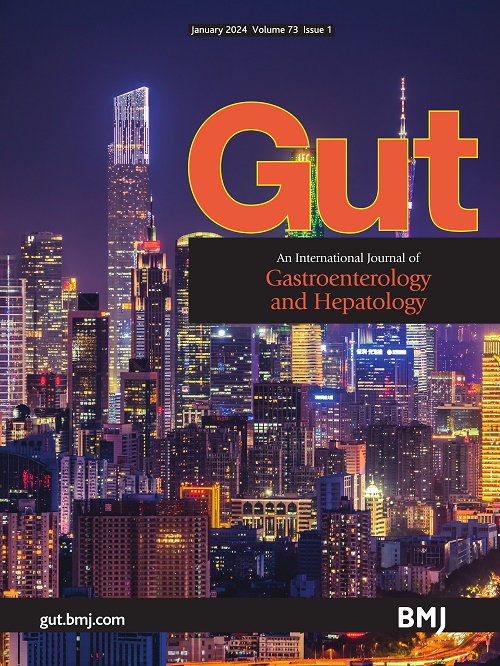Implementing discard strategies for diminutive polyps using autonomous CADx in clinical practice
IF 25.8
1区 医学
Q1 GASTROENTEROLOGY & HEPATOLOGY
引用次数: 0
Abstract
The strategy of discarding diminutive colonic polyps (≤5 mm) has been discussed for many years. However, despite their exceedingly low risk of malignancy, implementation has remained limited, with minimal impact on clinical practice. More recently, computer-assisted optical diagnosis (CADx) has been introduced to support and potentially enable broader adoption of this approach. We prospectively assessed patient acceptance and examiner-based quality control in 95 out of 102 patients (93.1%) who consented to this approach, involving a total of 149 polyps. Of these, 143 polyps were reviewed by three examiners blinded to CADx diagnoses and the results were compared with CADx diagnoses. Resect-and-discard accuracy was 83.5% excluding sessile serrated lesions (SSLs), while treating SSLs as neoplastic or hyperplastic yielded 75.9% and 84.3%, respectively. Excluding SSLs, the diagnose-and-leave negative predictive value was 92.3%. Surveillance interval recommendations based on CADx and expert review, aligned with current guidelines, achieved 100% concordance, ensuring appropriate follow-up. The rationale behind replacing histopathology for diminutive polyps using optical polyp diagnosis is rooted in the extremely low risk of advanced pathology in diminutive polyps, supporting the safe practice of discarding or leaving polyps in situ when accurately optically diagnosed. Adopting this approach would significantly reduce pathology-associated costs and offer immediate patient management decisions. This prospective clinical pilot study included patients aged 45–80 years undergoing elective colonoscopy at the Montreal University Hospital Center from August 2025 to November 2024. Patients were invited to a study replacing histopathological evaluations of diminutive polyps with autonomous computer-assisted optical (CADx) diagnosis. Exclusion criteria were inflammatory bowel disease, active colitis, familial polyposis syndromes, coagulopathy or severe medical comorbidities. Patients received detailed written and verbal explanations regarding autonomous use of CADx technology, and optical diagnosis polyp management strategies ( resect-and-discard and diagnose-and-leave ). All participants gave written informed consent. Patients declining participation completed a voluntary survey regarding their reasons. Of …在临床实践中应用自主CADx对小息肉实施丢弃策略
抛弃小型结肠息肉(≤5mm)的策略已被讨论多年。然而,尽管它们的恶性肿瘤风险极低,但实施仍然有限,对临床实践的影响很小。最近,计算机辅助光学诊断(CADx)已经被引入,以支持并可能使这种方法得到更广泛的采用。我们前瞻性地评估了102名患者中的95名(93.1%)同意采用该方法的患者的接受程度和基于检查员的质量控制,共涉及149个息肉。其中,143个息肉由三名不知道CADx诊断的检查人员检查,并与CADx诊断结果进行比较。排除无梗锯齿状病变(SSLs)的切除和丢弃准确率为83.5%,而将SSLs作为肿瘤或增生治疗的准确率分别为75.9%和84.3%。排除ssl后,诊断离开阴性预测值为92.3%。基于CADx和专家评审的监测间隔建议与现行指南保持一致,达到了100%的一致性,确保了适当的随访。使用光学息肉诊断替代小息肉组织病理学的基本原理是基于小息肉的晚期病理风险极低,支持在准确的光学诊断时丢弃或保留息肉原位的安全做法。采用这种方法将显著降低病理相关费用,并提供即时的患者管理决策。这项前瞻性临床试点研究纳入了2025年8月至2024年11月在蒙特利尔大学医院中心接受选择性结肠镜检查的45-80岁患者。患者被邀请参加一项研究,用自主计算机辅助光学(CADx)诊断代替小息肉的组织病理学评估。排除标准为炎症性肠病、活动性结肠炎、家族性息肉病综合征、凝血功能障碍或严重的医学合并症。患者收到了关于自主使用CADx技术的详细书面和口头解释,以及光学诊断息肉管理策略(切除并丢弃和诊断并离开)。所有参与者均给予书面知情同意。拒绝参与的患者完成了一项关于其原因的自愿调查。的……
本文章由计算机程序翻译,如有差异,请以英文原文为准。
求助全文
约1分钟内获得全文
求助全文
来源期刊

Gut
医学-胃肠肝病学
CiteScore
45.70
自引率
2.40%
发文量
284
审稿时长
1.5 months
期刊介绍:
Gut is a renowned international journal specializing in gastroenterology and hepatology, known for its high-quality clinical research covering the alimentary tract, liver, biliary tree, and pancreas. It offers authoritative and current coverage across all aspects of gastroenterology and hepatology, featuring articles on emerging disease mechanisms and innovative diagnostic and therapeutic approaches authored by leading experts.
As the flagship journal of BMJ's gastroenterology portfolio, Gut is accompanied by two companion journals: Frontline Gastroenterology, focusing on education and practice-oriented papers, and BMJ Open Gastroenterology for open access original research.
 求助内容:
求助内容: 应助结果提醒方式:
应助结果提醒方式:


